Study of the Forming Characteristics of Small-Caliber Ammunition with Circumferential MEFP
Abstract
1. Introduction
2. Structural Design and Analysis
3. Numerical Model of Integral Circumferential MEFP Warhead
3.1. Finite-Element Model of Integral Circumferential MEFP Warhead
3.2. Material Model
4. Numerical Simulation Results of Integral Circumferential MEFP Warhead
4.1. Forming Results of Integral Circumferential MEFP Warhead
1#EFP-4#EFP Forming Velocity of the Integral Circumferential MEFP Warhead
5. Influence of the Parameters of the Liner on the Shape and Speed of MEFP
5.1. Structural Design of MEFP
5.2. Simulation Results and Analysis
5.2.1. Forming Results of R1 = 10 mm
5.2.2. Forming Results of R1 = 12 mm
6. Conclusions
Author Contributions
Funding
Conflicts of Interest
References
- Lu, Y.F.; Li, X.Y.; Lin, Y.L. Structure and Principle of Warhead; Science Press: Beijing, China, 2009. [Google Scholar]
- Zhao, C.X.; Qian, F.; Xu, J.G.; Cao, H.A.; Ji, C.; Lu, L. Effect of Liner Configuration Parameters on Formation of Integral MEFP. Chin. J. Energ. Mater. 2016, 24, 485–490. [Google Scholar]
- Zhao, C.X.; Ran, D.Y.; Liu, K. Effect of Charge Parameters on Formation of Integral Multiple Explosively Formed Projectiles. Chin. J. Energ. Mater. 2017, 25, 882–887. [Google Scholar]
- Zhao, C.X.; Long, Y.; Ji, C. Numerical Simulation and Experimental Research on Integral Multiple Explosively Formed Projectile Warhead. Acta Armamentarii 2013, 34, 1392–1397. [Google Scholar]
- Liu, J.F.; Long, Y.; Ji, C.; Xu, Q.J.; Gao, F.Y.; Zhao, C.X. Numerical and Experimental Study on the Formation and Dispersion Patterns of Multiple Explosively Formed Penetrators. Lat. Am. J. Solids Struct. 2017, 14, 685–699. [Google Scholar] [CrossRef][Green Version]
- Liu, J.F.; Long, Y.; Ji, C.; Zhong, M.; Liu, Y.; Li, X. Experimental and Numerical Study on the Dispersion Patterns and Penetration Properties of MEFP with Seven Arc-Cone Liners. Lat. Am. J. Solids Struct. 2017, 14, 1064–1084. [Google Scholar] [CrossRef][Green Version]
- Cao, M.Y.; Wang, J.X.; Hao, C.J.; Tang, K.; Huang, R.; Zhou, N. Study on penetration performance and distribution characters of multi-explosively formed projectiles. In Proceedings of the 30th International Symposium on Ballistics, Long Beach, CA, USA, 11–15 September 2017; pp. 1435–1446. [Google Scholar]
- Richard, F.; Ng, W.; Bernard, R. Multiple Explosively Formed Penetrator (MEFP) Warhead Technology Development. In Proceedings of the 19th International Symposium on Ballistics, Interlaken, Switzerland, 7–11 May 2001. [Google Scholar]
- Zhao, C.X.; Long, Y.; Sui, Y.S.; Ji, C.; Zhou, X. Influent of initiation methods on formation of integral MEFP warhead parameter. J. PLA Univ. Sci. Technol. Nat. Sci. Ed. 2012, 13, 559–564. [Google Scholar]
- Li, P.; Yuan, B.H.; Sun, X.Y. Experimental Research on Eccentric Initiation MEFP Warhead. Acta Armamentarii 2017, 38, 447–453. [Google Scholar]
- Liang, Z.G.; Chen, B.X.; Nan, Y.X.; Jiang, J.W.; Ding, L. Research on the computing method for the forming velocity of circumferential multiple explosive formed projectiles. J. Def. Model. Simul. 2019, 1–12. [Google Scholar] [CrossRef]
- Liang, Z.G.; Jiang, J.W. A Numerical Analysis on the Forming Law of Circumferential MEFP. J. Proj. Rockets Missiles Guid. 2015, 35, 57–64. [Google Scholar]
- Yin, J.P.; Yao, Z.H.; Wang, Z.J. Influence of Liner Parameters on the Forming of Circumferential MEFP. Chin. J. Explos. Propellants 2011, 34, 53–57. [Google Scholar]
- Zheng, C.J.; Chen, Z.G.; Fu, J.P.; Zhang, X.Z.; Wang, W.Z.; Lan, Y.P. The structural design of integral MEFP warhead. Mach. Des. Manuf. Eng. 2018, 47, 123–127. [Google Scholar]
- Fu, L.; Yin, J.P.; Wang, Z.J.; Fu, S.P. Orthogonal Optimization Design on a MEFP Warhead Structure. Fire Control Command Control 2012, 37, 184–187. [Google Scholar]
- Cao, M.Y.; Wang, J.X.; Hao, C.J.; Song, H.P.; Zhang, Y.N.; Zhou, L.; Zhou, N.; Tang, K. Formation and Penetration Performance of Multi-Explosively Formed Projectiles. Chin. J. High Press. Phys. 2017, 31, 487–493. [Google Scholar]
- Zhou, X.; Long, Y.; Yu, D.Q. Numerical Simulation and Effect Analysis for Radial Dispersion of MEFP. Acta Armamentarii 2006, 27, 23–26. [Google Scholar]
- Men, J.B.; Jiang, J.W.; Wang, S.Y. Fundamentals of Numerical Simulation for Explosion and Shock Problems; Beijing Institute of Technology Press: Beijing, China, 2015. [Google Scholar]
- Guo, H.G.; Zheng, Y.F.; Yu, Q.B.; Ge, C.; Wang, H.F. Penetration behavior of reactive liner shaped charge jet impacting steel plates. Int. J. Impact Eng. 2019, 126, 76–84. [Google Scholar] [CrossRef]
- Liu, J.F.; Long, Y.; Ji, C.; Zhong, M.S.; Liu, Q. The influence of liner material on the dynamic response of the finite steel target subjected to high velocity impact by explosively formed projectile. Int. J. Impact Eng. 2017, 109, 264–275. [Google Scholar] [CrossRef]
- Yin, J.P.; Han, Y.Y.; Wang, X.F.; Chang, B.H.; Dong, F.D.; Xu, Y.J. A new charge structure based on computer modeling and simulation analysis. J. Vis. Commun. Image Represent. 2019, 64, 102613. [Google Scholar] [CrossRef]
- Steinberg, D.J. Equation of State and Strength Properties of Selected Materials, UCRL-MA-106439; Lawrence Livermore National Laboratory: Livermore, CA, USA, 1991. [Google Scholar]
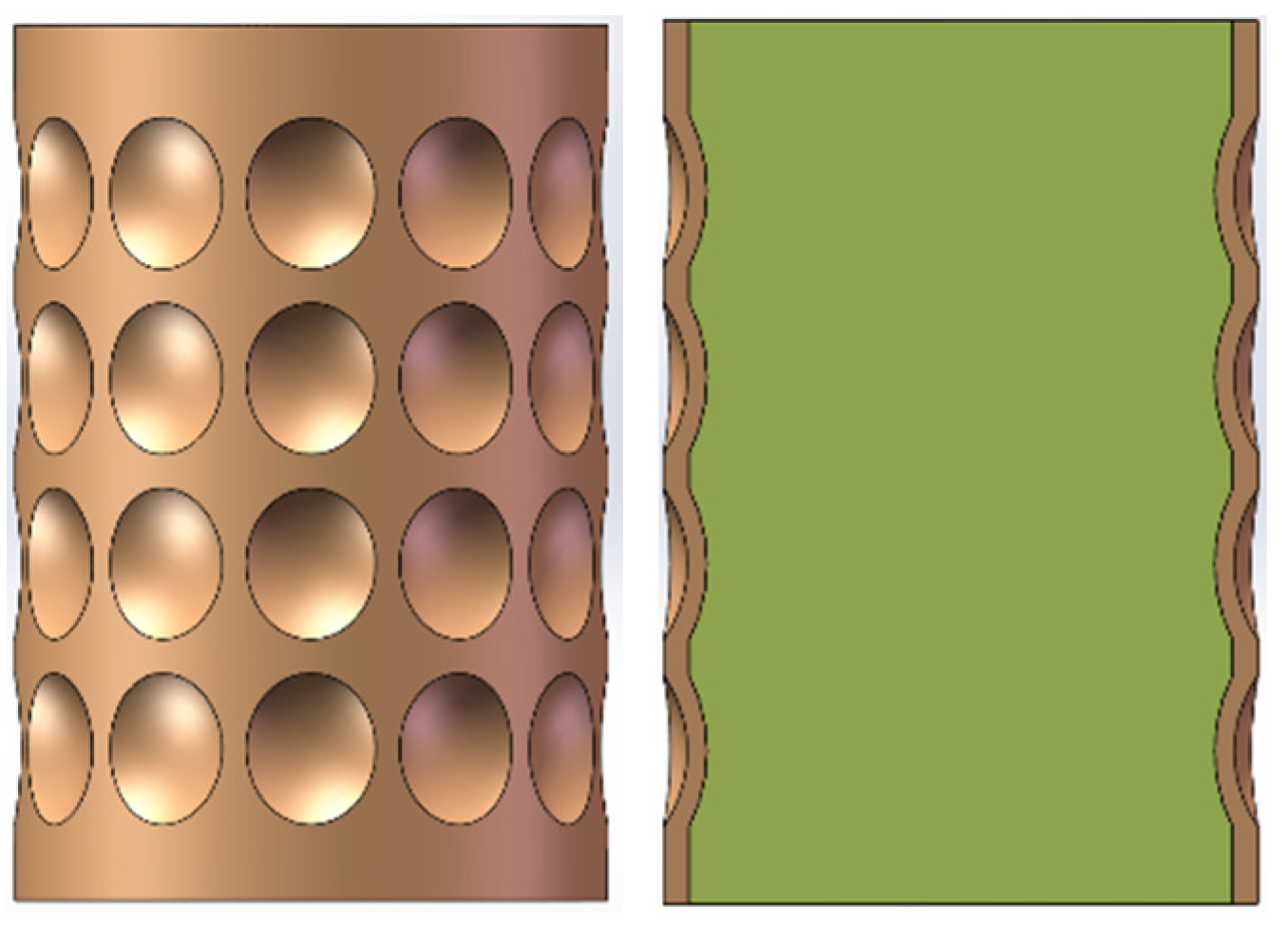

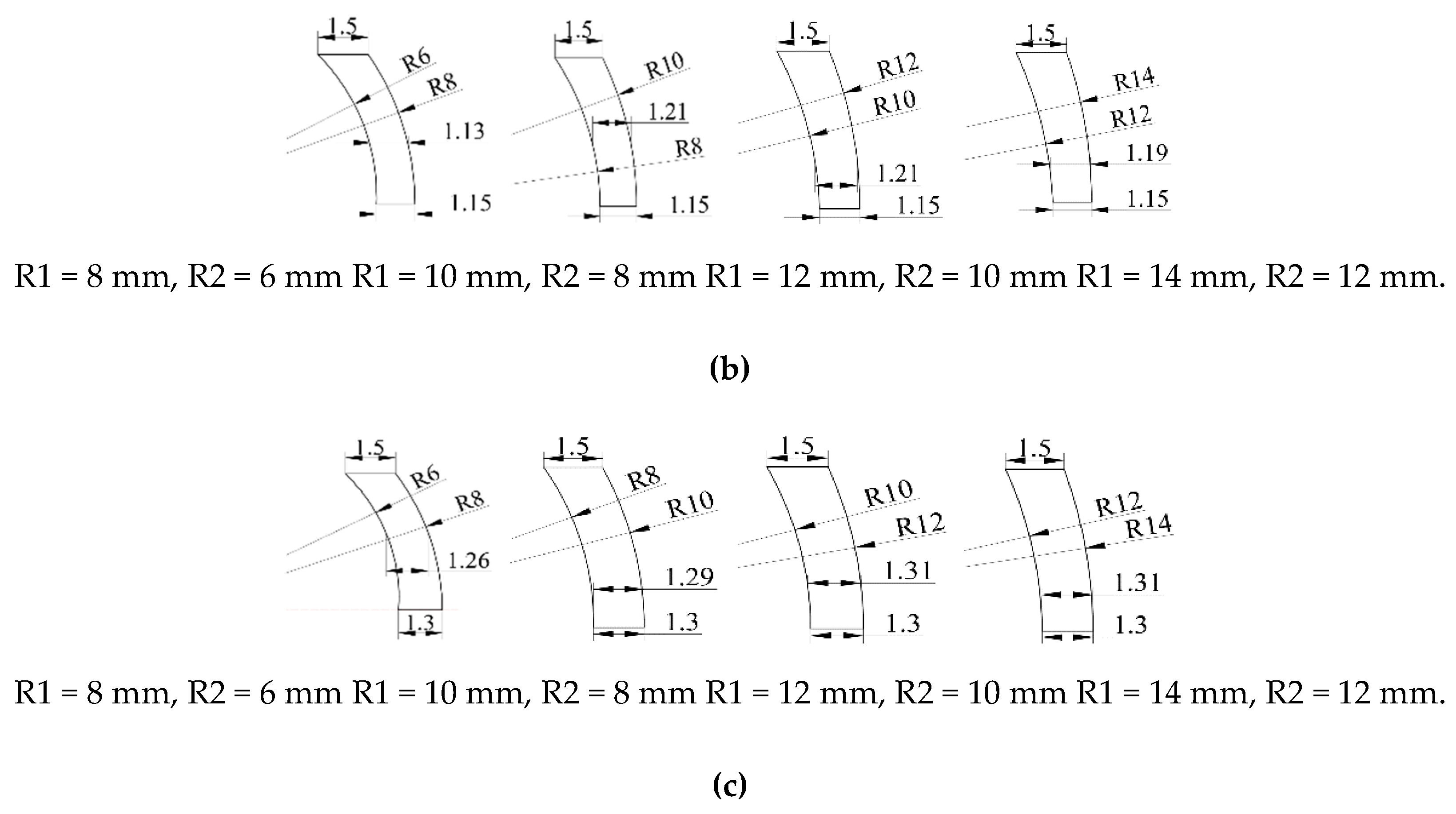
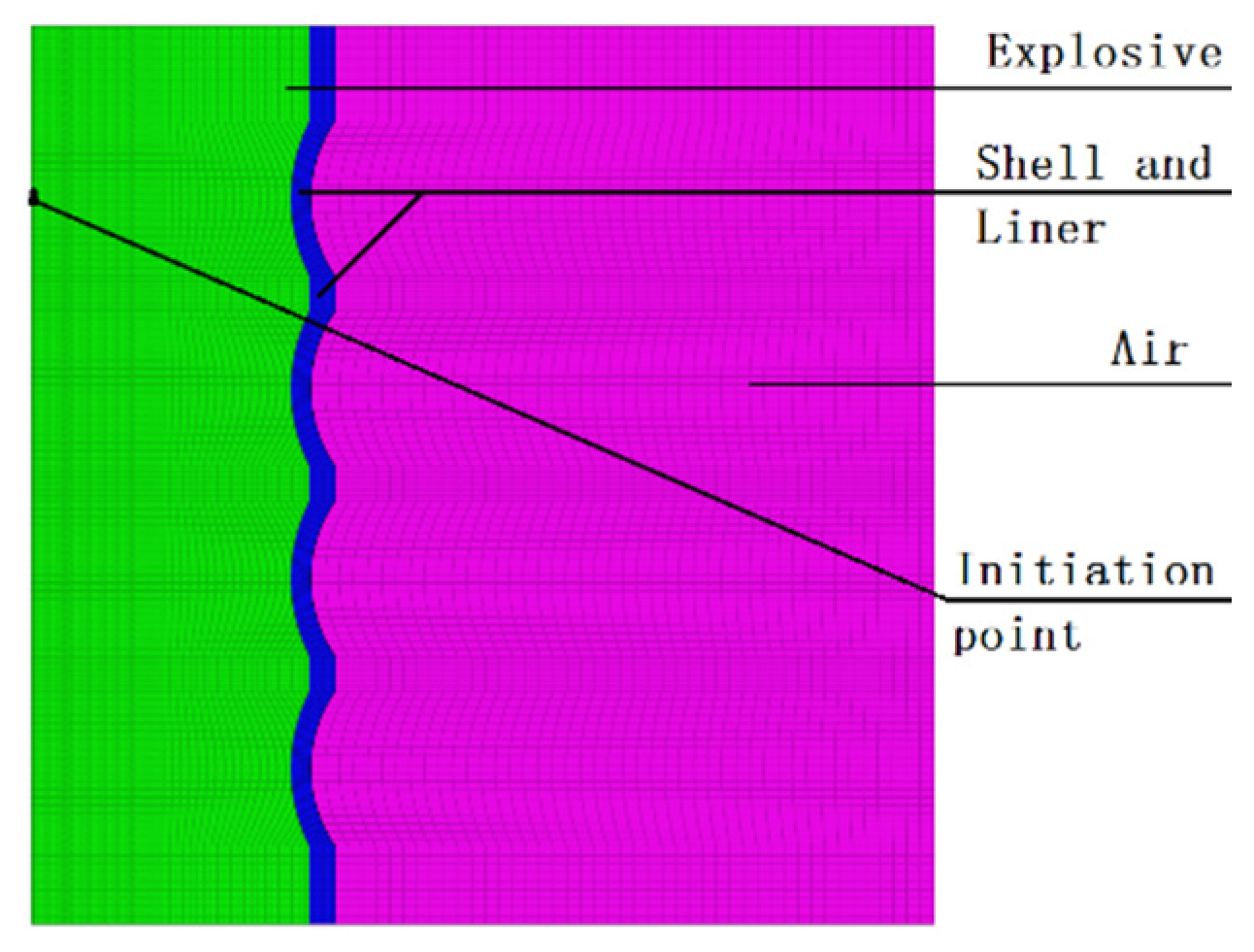
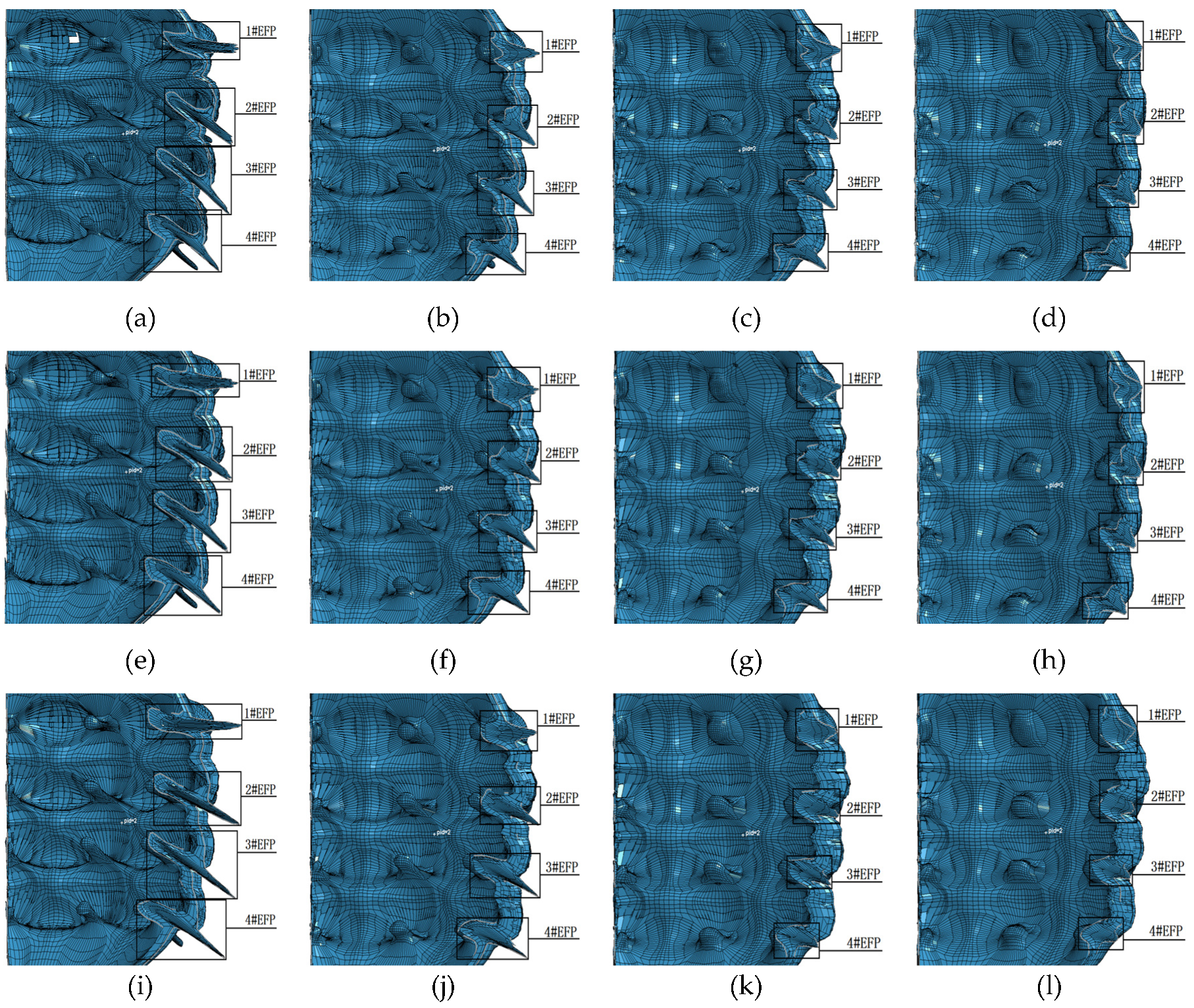
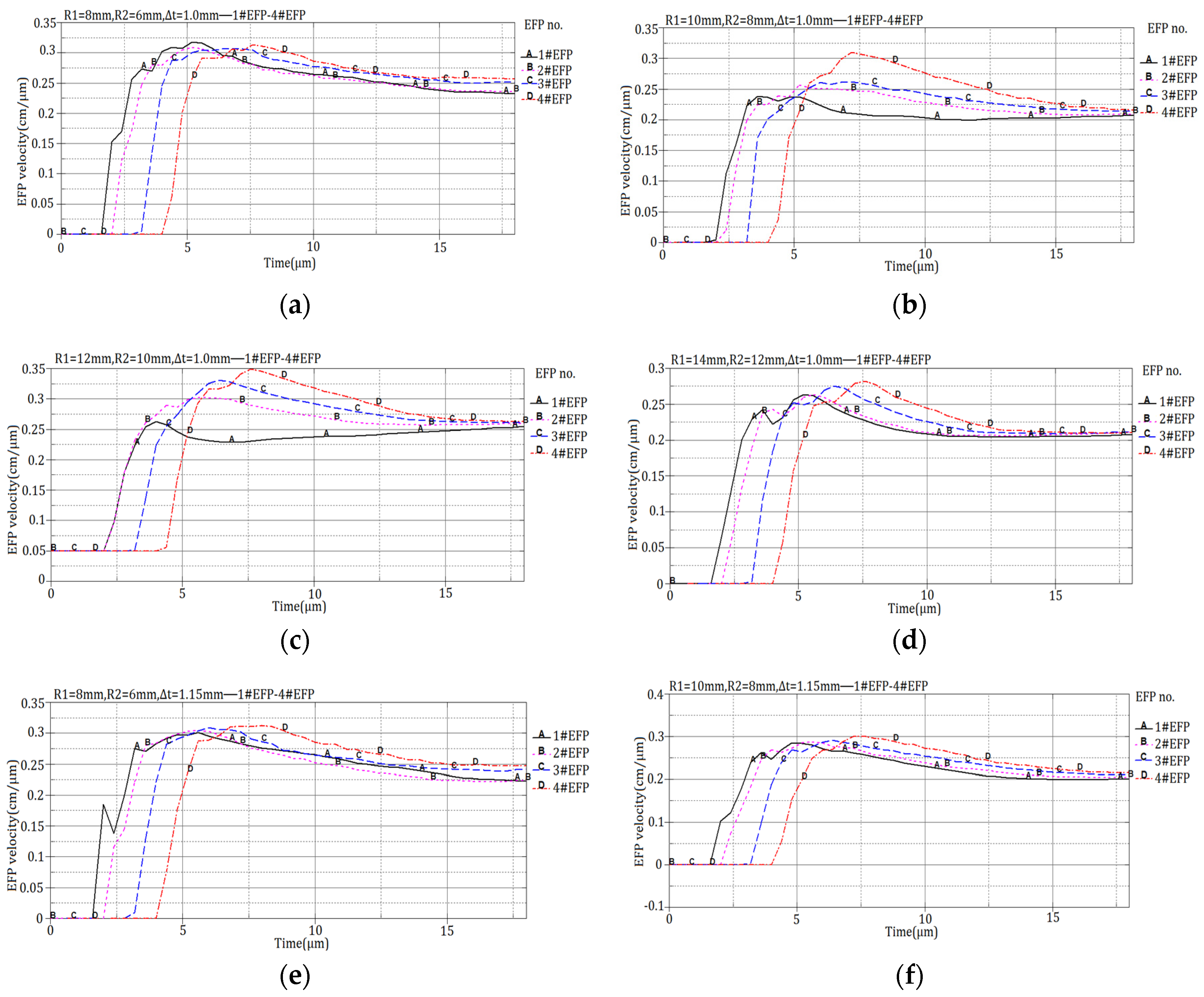
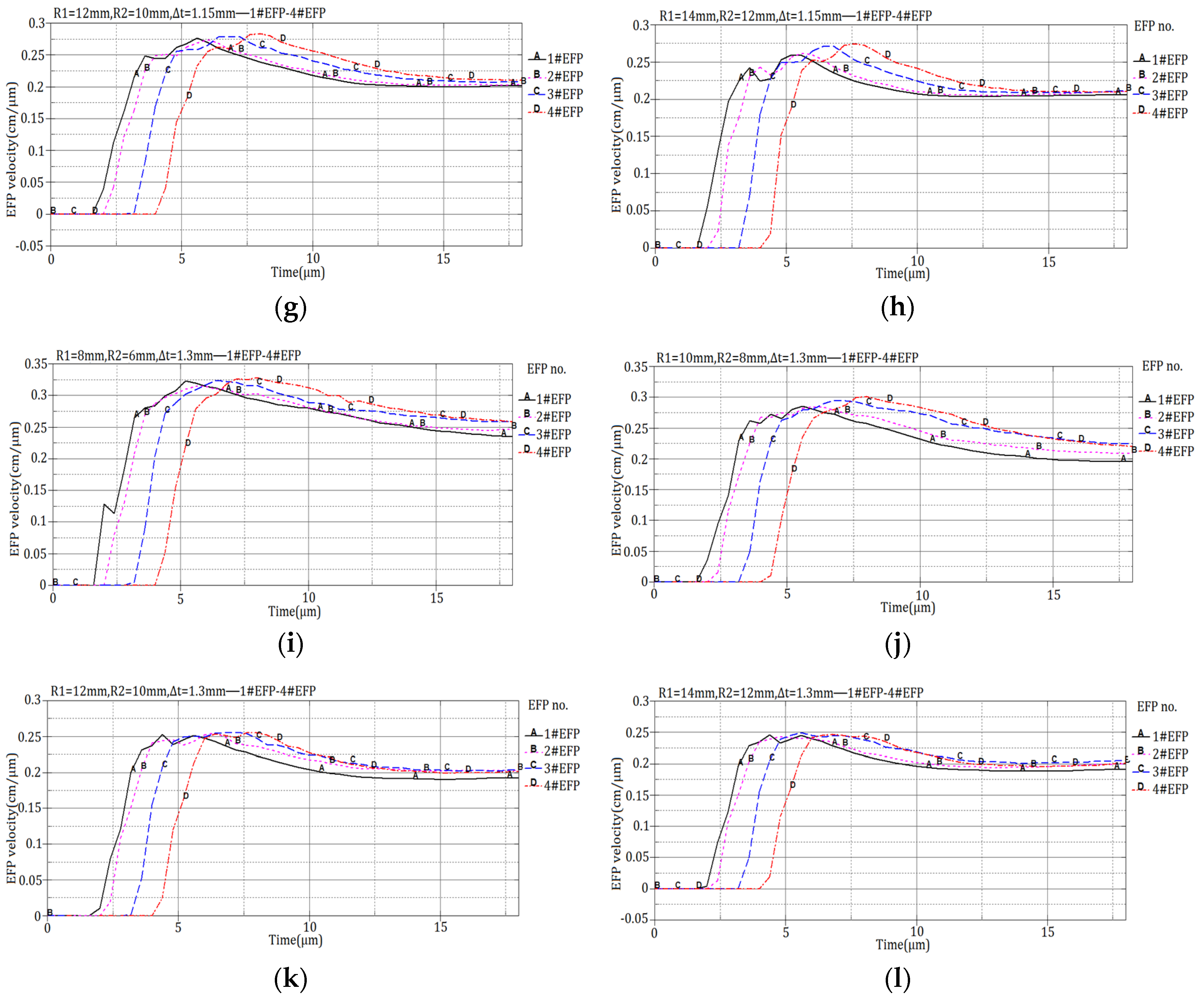
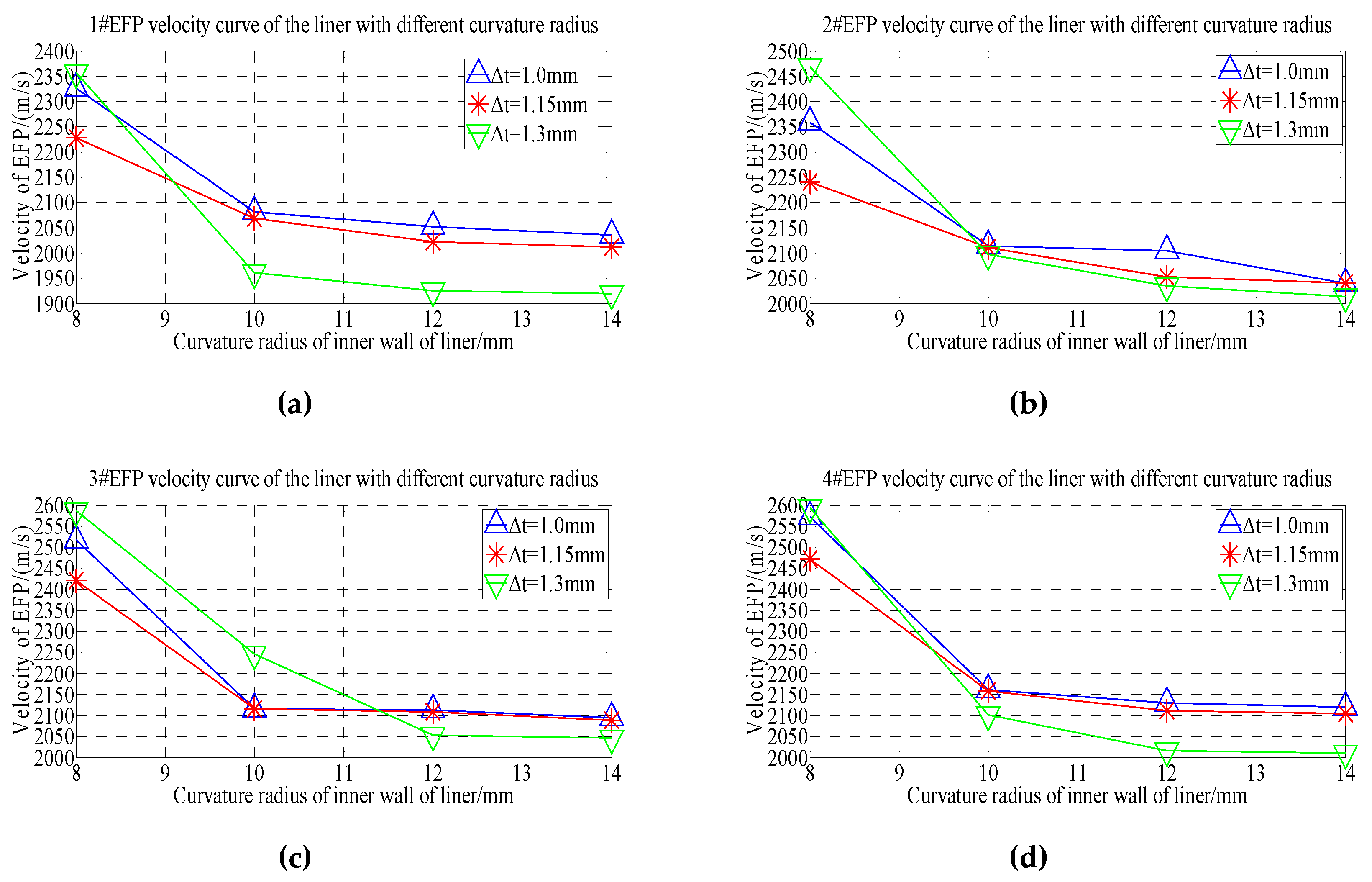

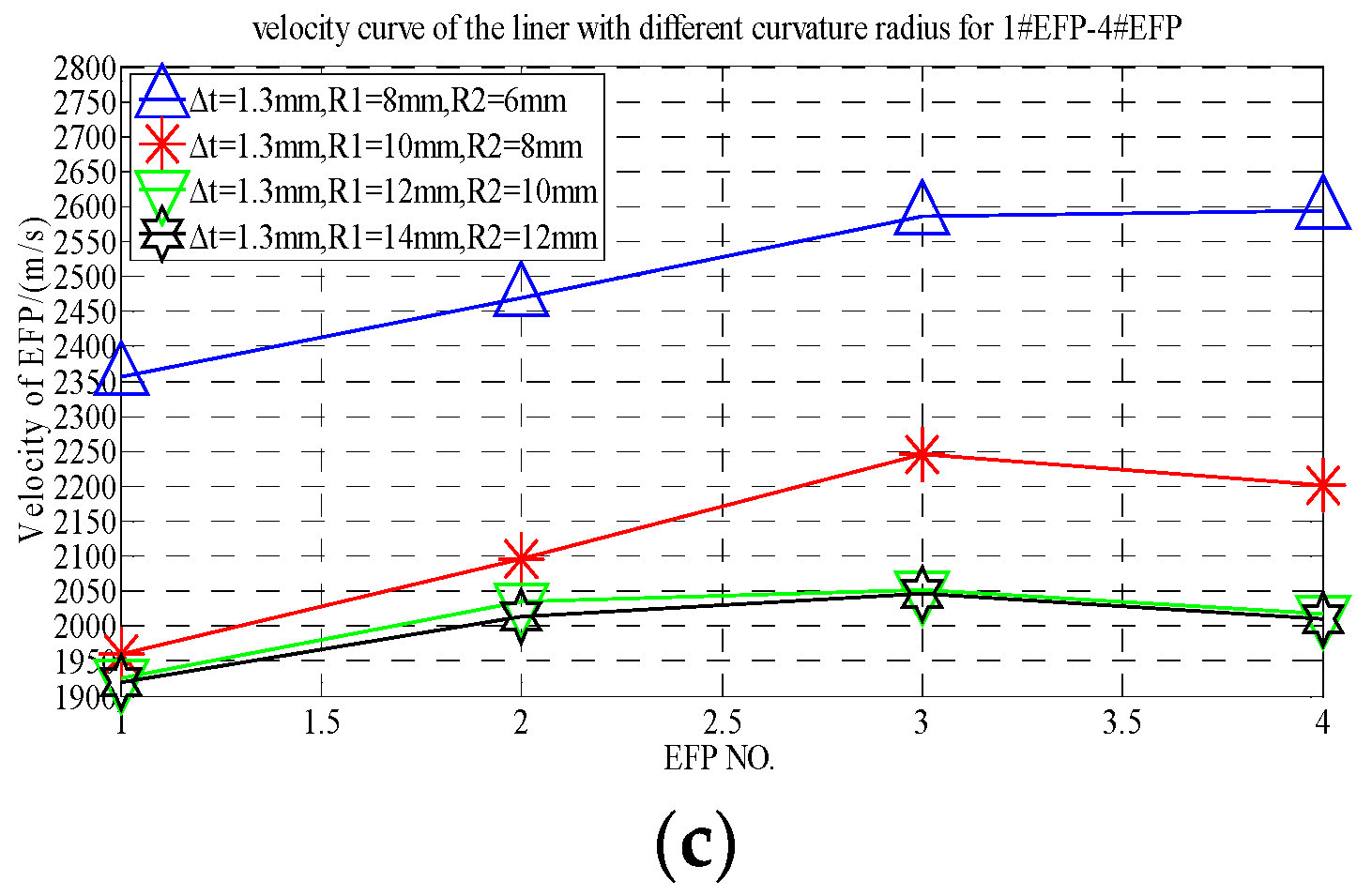

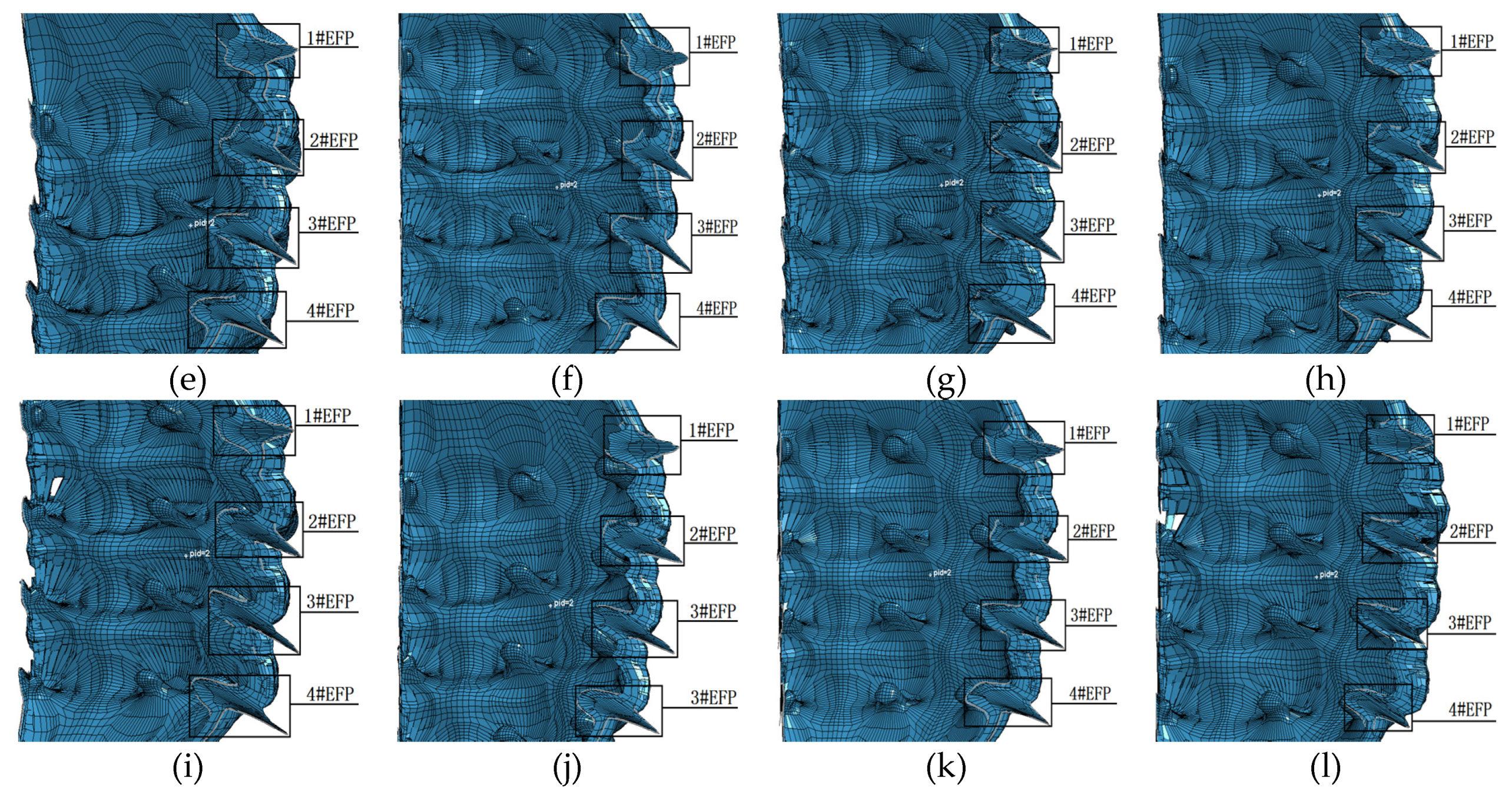

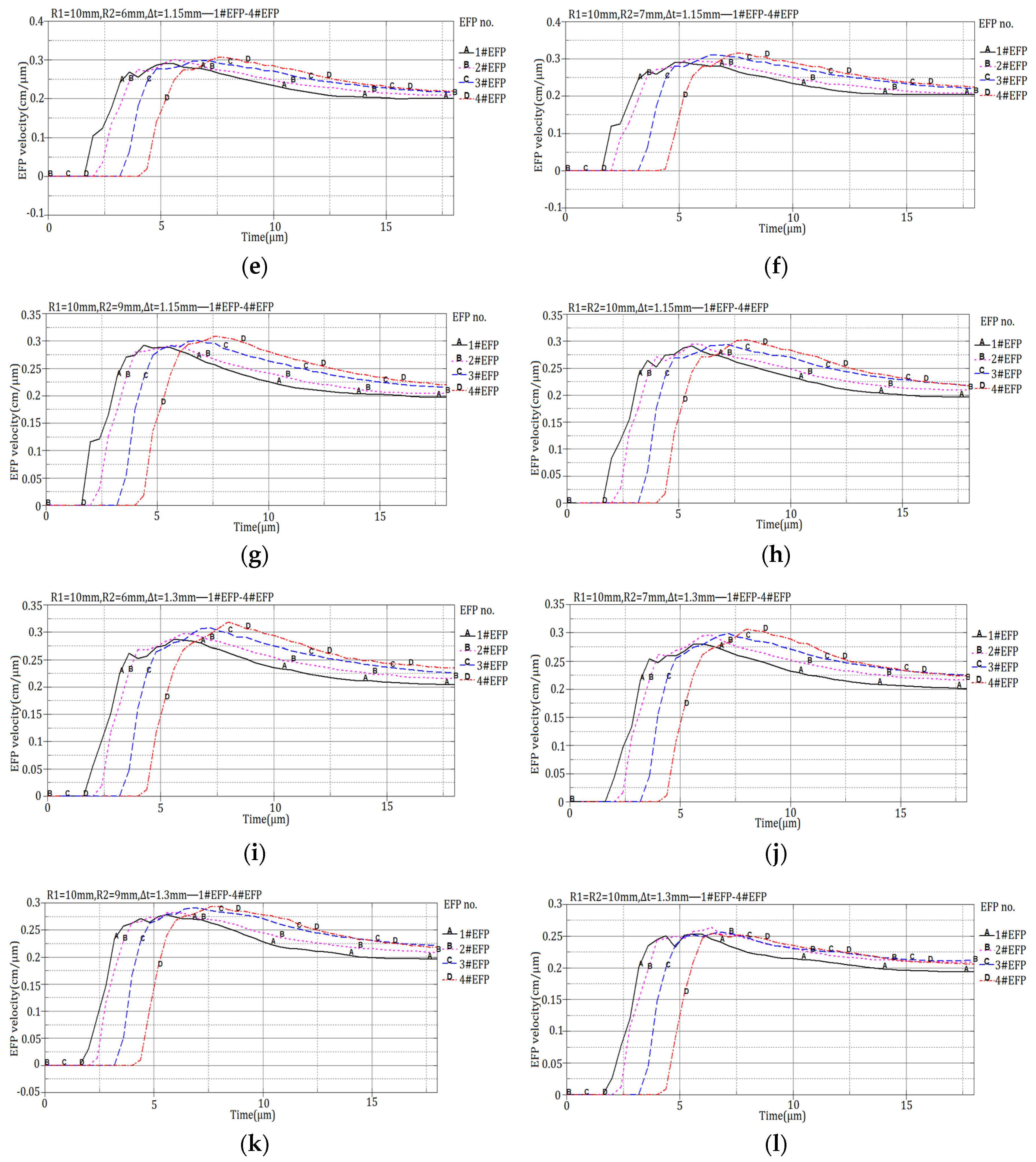
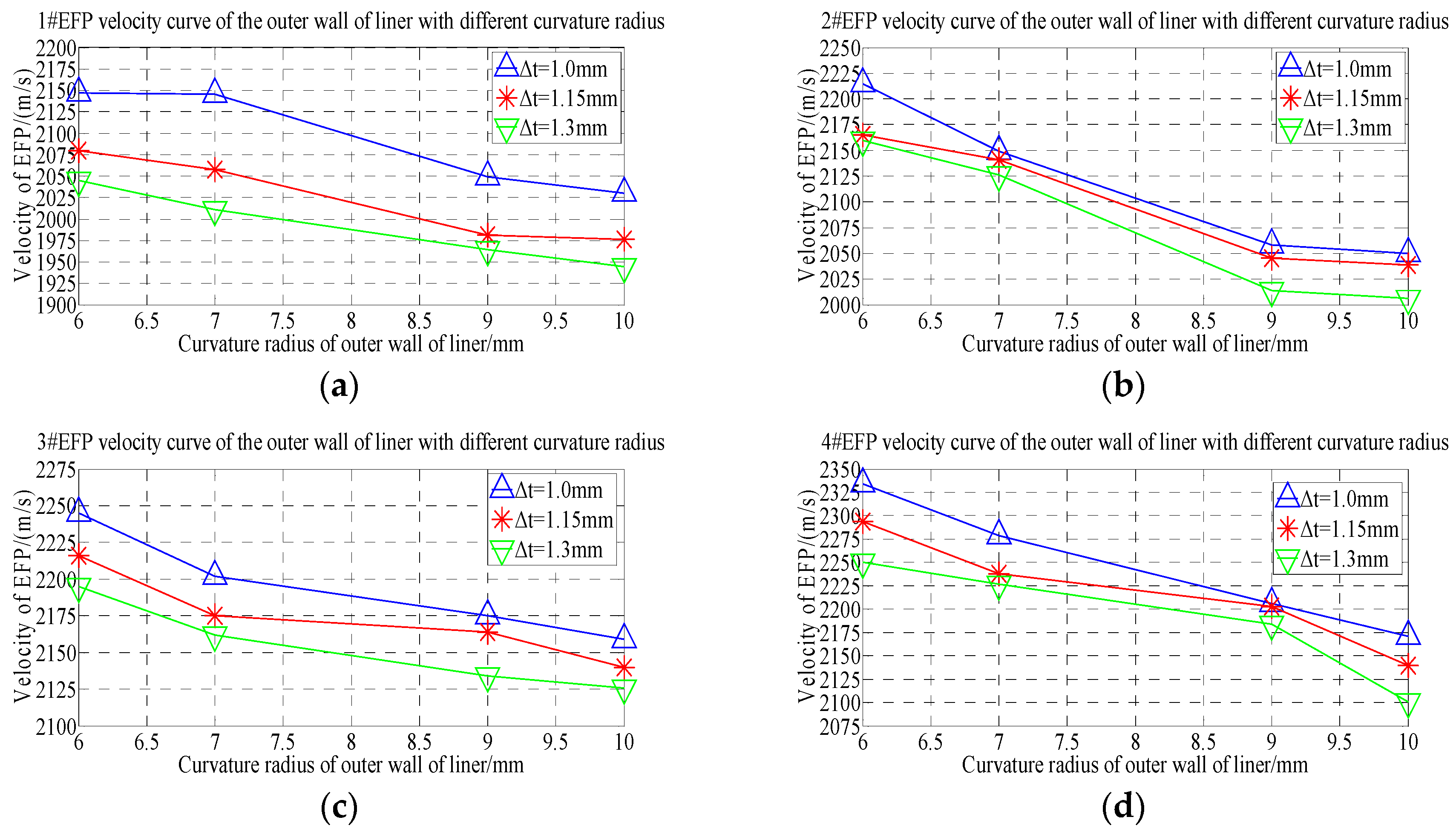
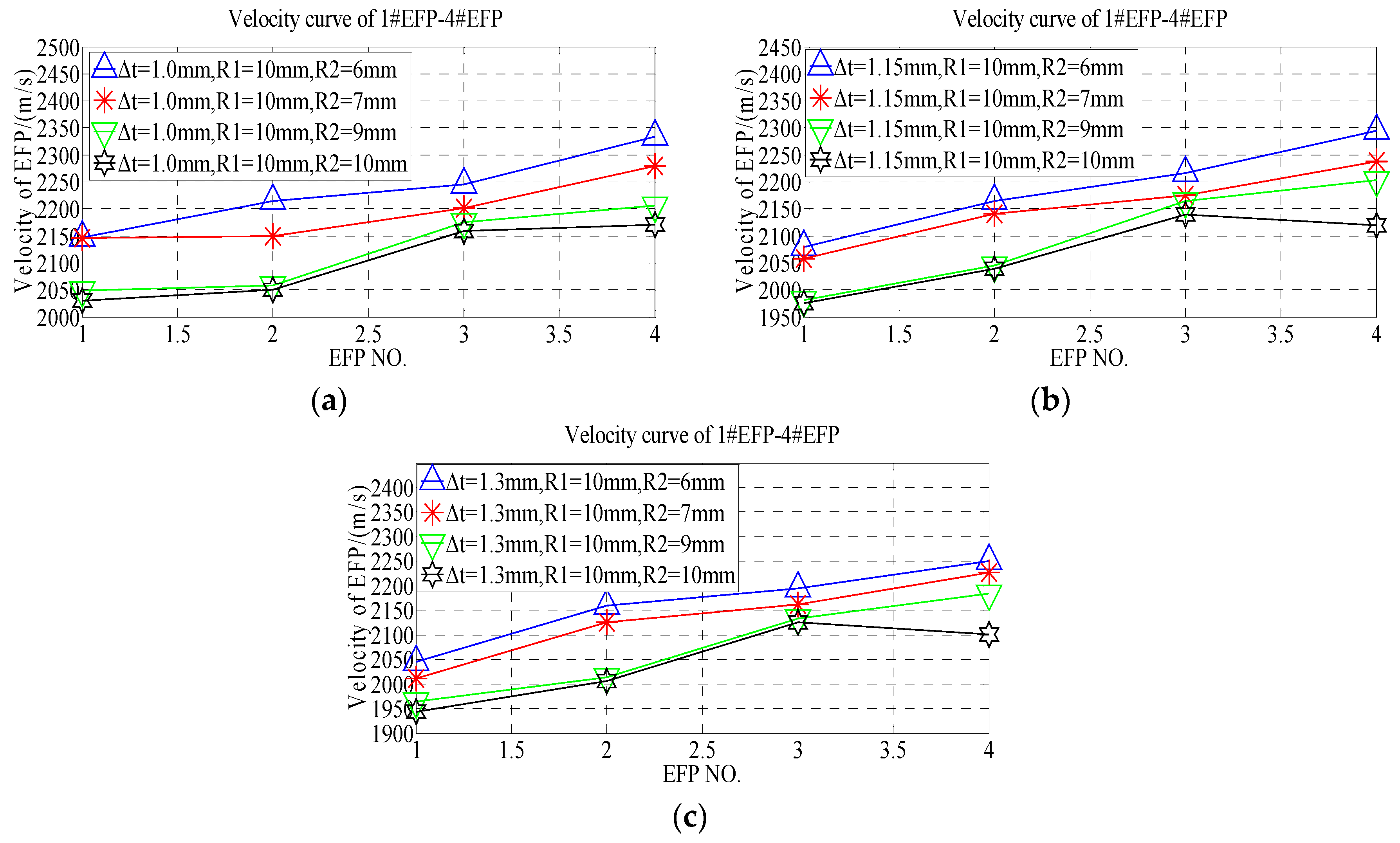

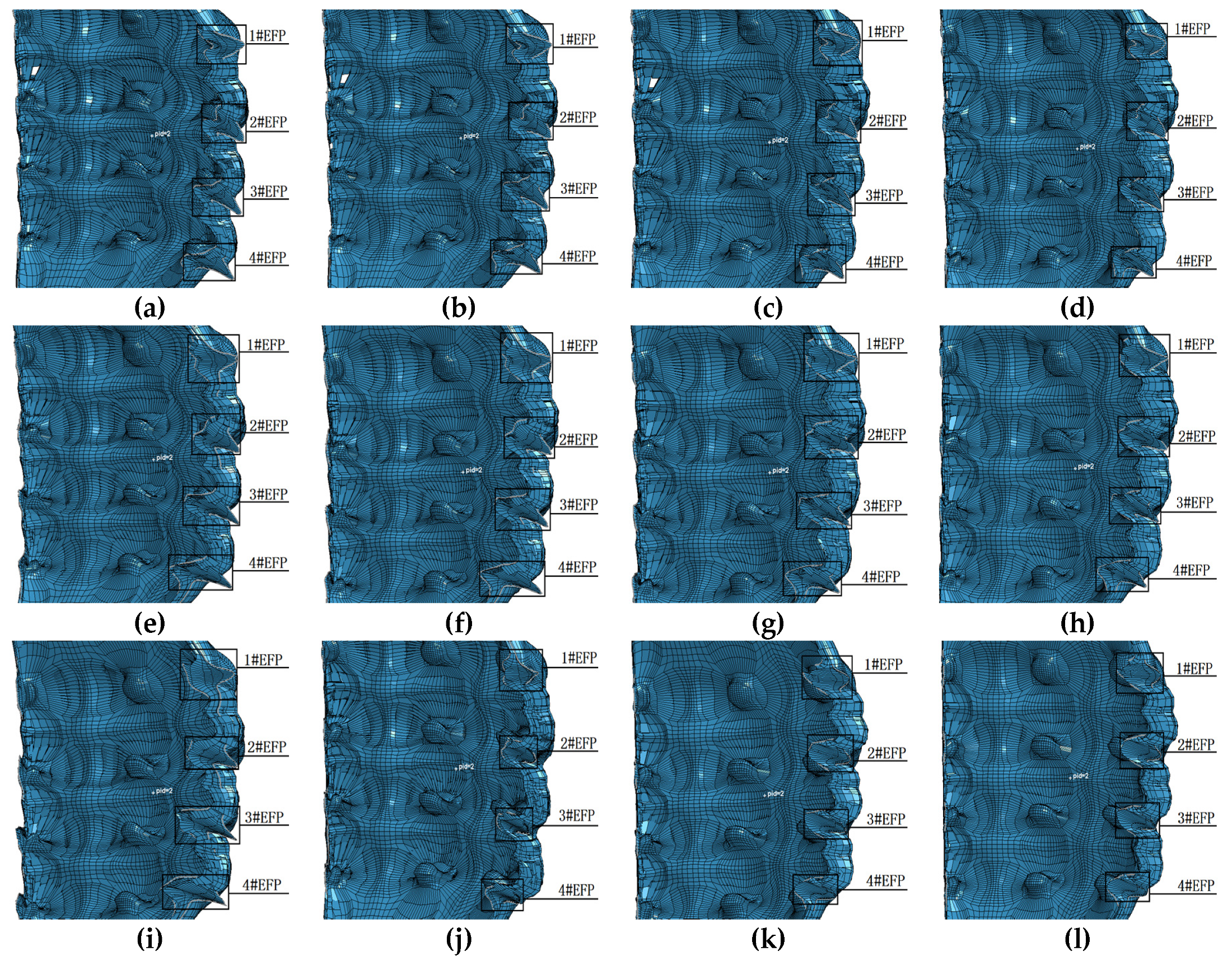

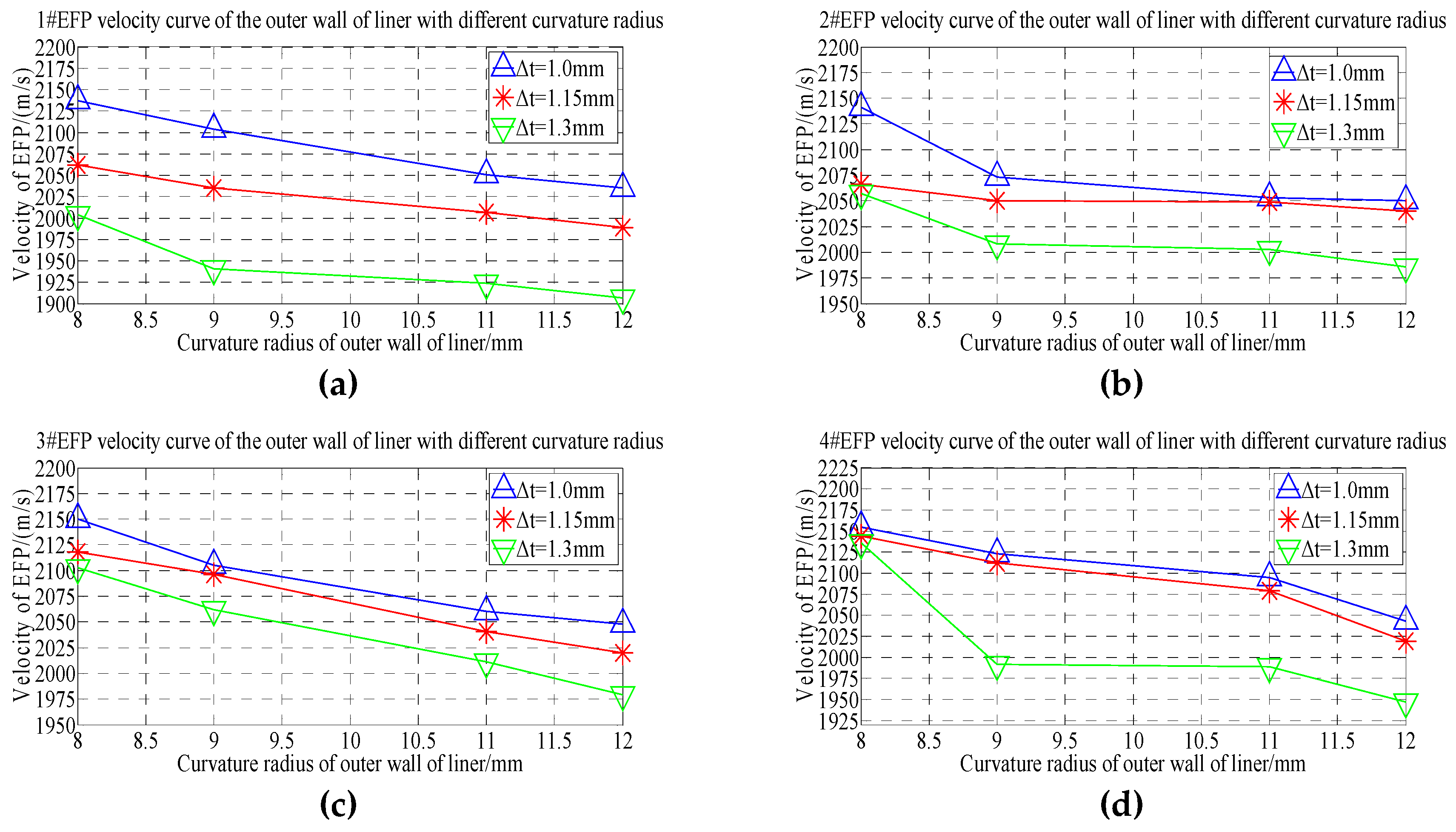
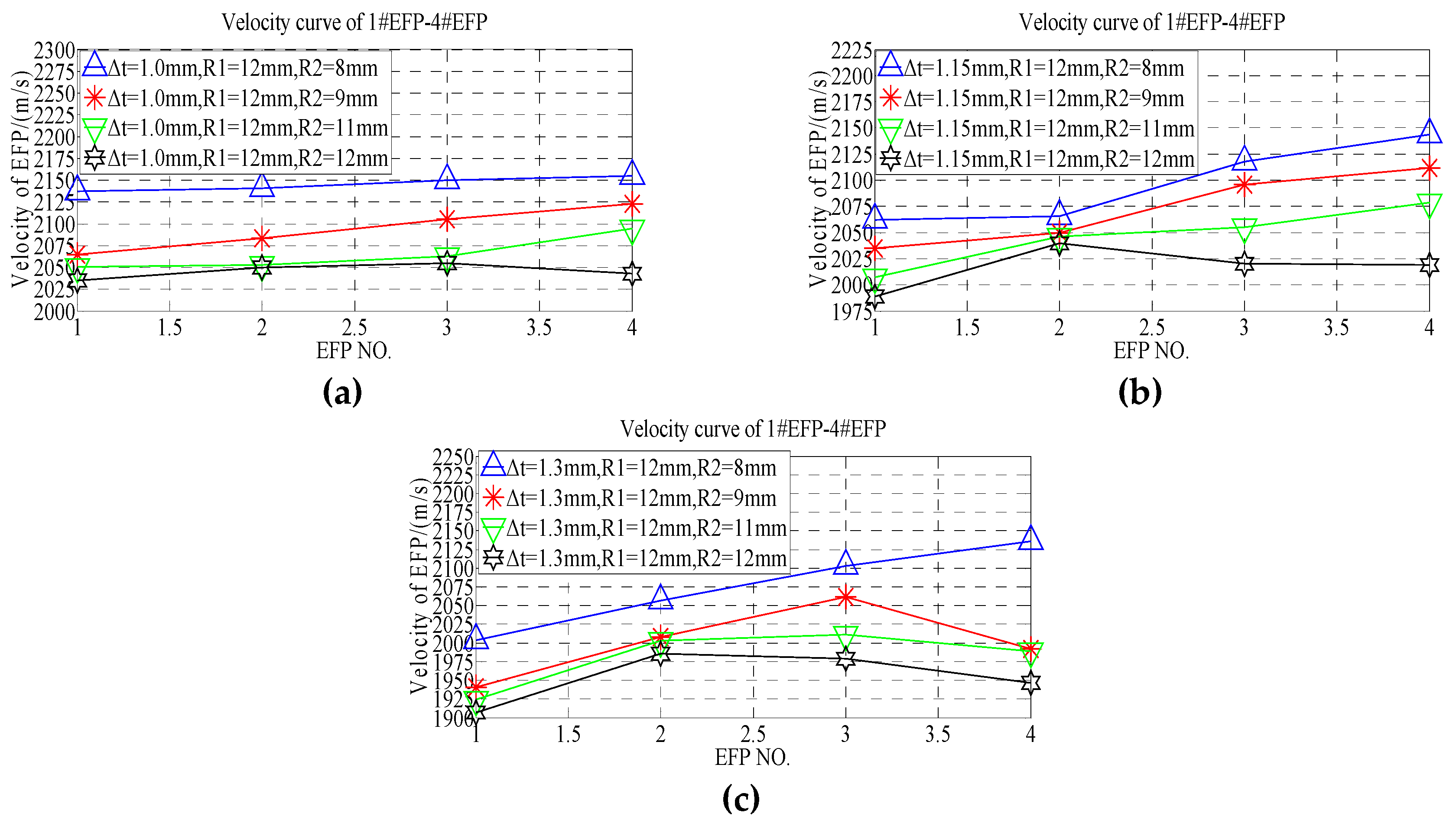
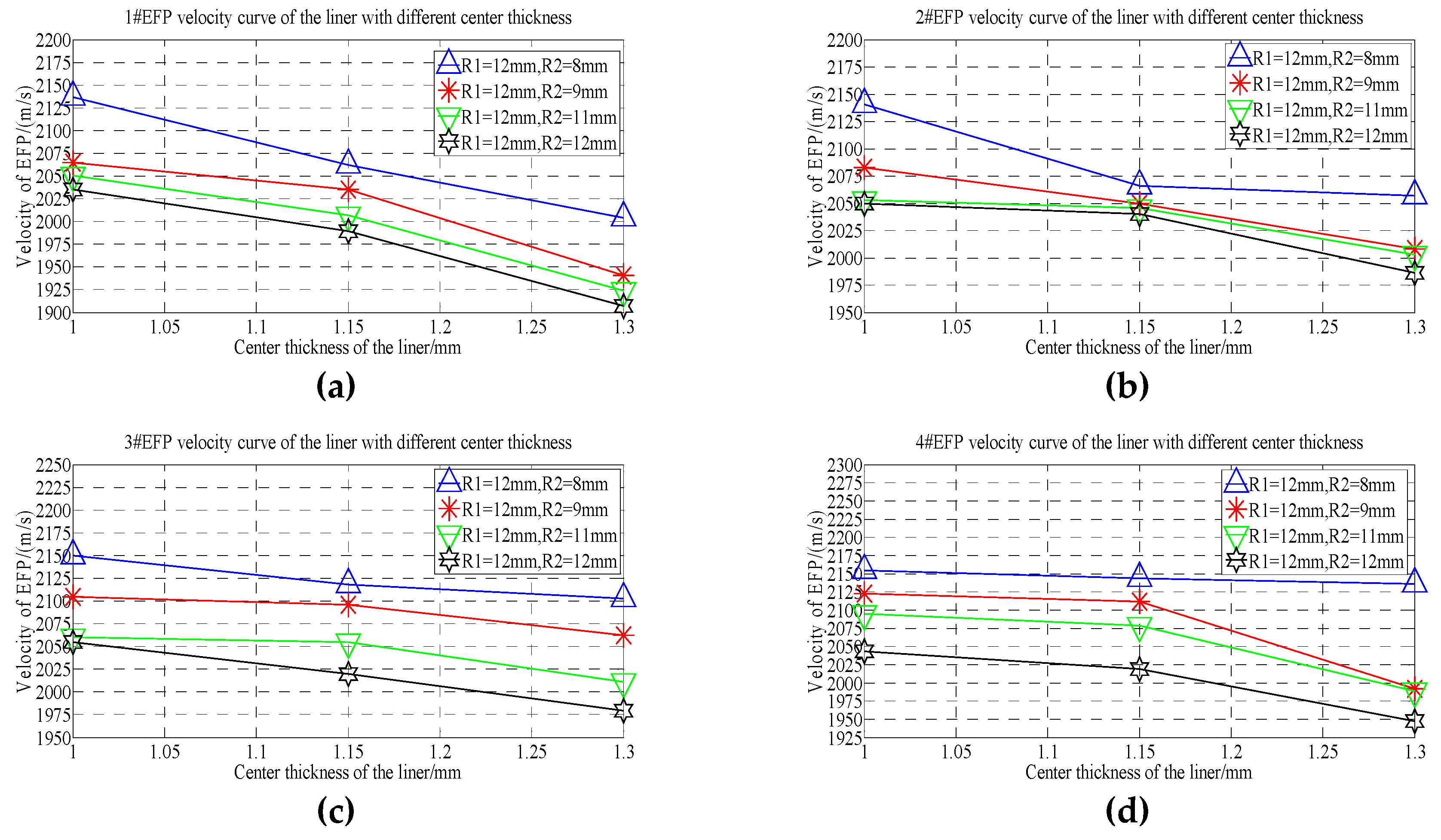
| Basic Parameters of MEFP | Scheme | Curvature Radius of Inner Wall of Liner (R1) | Curvature Radius of Outer Wall of Liner (R2) | |
|---|---|---|---|---|
| The charging height is 52 mm, the diameter of the charging is 37 mm, the shell thickness is 1.5 mm, and the diameter of the liner is 9 mm | 1 | 1 mm | 8 mm | 6 mm |
| 2 | 10 mm | 8 mm | ||
| 3 | 12 mm | 10 mm | ||
| 4 | 14 mm | 12 mm | ||
| 5 | 1.15 mm | 8 mm | 6 mm | |
| 6 | 10 mm | 8 mm | ||
| 7 | 12 mm | 10 mm | ||
| 8 | 14 mm | 12 mm | ||
| 9 | 1.3 mm | 8 mm | 6 mm | |
| 10 | 10 mm | 8 mm | ||
| 11 | 12 mm | 10 mm | ||
| 12 | 14 mm | 12 mm |
| Material | (g/cm3) | D | E (GPa) | A (GPa) | B (GPa) | |||||
|---|---|---|---|---|---|---|---|---|---|---|
| Explosive | 1.71 | 0.83 | 28.6 | 8.5 | 524.23 | 7.678 | 34 | 1.1 | 0.34 | 1 |
| Material | (g/cm3) | G (GPa) | A (MPa) | B (MPa) | C | S | ||||||
|---|---|---|---|---|---|---|---|---|---|---|---|---|
| Copper | 8.93 | 46.5 | 90 | 292 | 0.31 | 0.025 | 1.09 | 1356 | 293 | 2.02 | 0.39 | 1.49 |
| Material | (kJ/kg·k) | (kJ/kg·k) | T(K) | |||
|---|---|---|---|---|---|---|
| Air | 1.225 | 1.4 | 1.005 | 0.718 | 288.2 | 206,800 |
| Projectile Number | Radius of Curvature | t = 1 mm | t = 1.15 mm | = 1.3 mm |
|---|---|---|---|---|
| 1#EFP | R1 = 8 mm, R2 = 6 mm | 2326 m/s | 2228 m/s | 2357 m/s |
| R1 = 10 mm, R2 = 8 mm | 2081 m/s | 2068 m/s | 1961 m/s | |
| R1 = 12 mm, R2 = 10 mm | 2052 m/s | 2022 m/s | 1926 m/s | |
| R1 = 14 mm, R2 = 12 mm | 2035 m/s | 2012 m/s | 1920 m/s | |
| 2#EFP | R1 = 8 mm, R2 = 6 mm | 2359 m/s | 2241 m/s | 2469 m/s |
| R1 = 10 mm, R2 = 8 mm | 2114 m/s | 2110 m/s | 2097 m/s | |
| R1 = 12 mm, R2 = 10 mm | 2105 m/s | 2053 m/s | 2035 m/s | |
| R1 = 14 mm, R2 = 12 mm | 2040 m/s | 2041 m/s | 2014 m/s | |
| 3#EFP | R1 = 8 mm, R2 = 6 mm | 2517 m/s | 2421 m/s | 2586 m/s |
| R1 = 10 mm, R2 = 8 mm | 2115 m/s | 2115 m/s | 2246 m/s | |
| R1 = 12 mm, R2 = 10 mm | 2113 m/s | 2108 m/s | 2053 m/s | |
| R1 = 14 mm, R2 = 12 mm | 2094 m/s | 2088 m/s | 2046 m/s | |
| 4#EFP | R1 = 8 mm, R2 = 6 mm | 2573 m/s | 2472 m/s | 2594 m/s |
| R1 = 10 mm, R2 = 8 mm | 2161 m/s | 2158 m/s | 2102 m/s | |
| R1 = 12 mm, R2 = 10 mm | 2130 m/s | 2111 m/s | 2017 m/s | |
| R1 = 14 mm, R2 = 12 mm | 2120 m/s | 2104 m/s | 2011 m/s |
| Basic Parameters of MEFP | Curvature Radius of Inner Wall of Liner (R1) | Curvature Radius of Outer Wall of Liner (R2) | |
|---|---|---|---|
| The charging height is 52 mm, the diameter of the charging is 37 mm, the shell thickness is 1.5 mm, and the diameter of the liner is 9 mm | 1 mm | 10 mm | 6 mm |
| 7 mm | |||
| 9 mm | |||
| 10 mm | |||
| 12 mm | 8 mm | ||
| 9 mm | |||
| 11 mm | |||
| 12 mm | |||
| 1.15 mm | 10 mm | 6 mm | |
| 7 mm | |||
| 9 mm | |||
| 10 mm | |||
| 12 mm | 8 mm | ||
| 9 mm | |||
| 11 mm | |||
| 12 mm | |||
| 1.3 mm | 10 mm | 6 mm | |
| 7 mm | |||
| 9 mm | |||
| 10 mm | |||
| 12 mm | 8 mm | ||
| 9 mm | |||
| 11 mm | |||
| 12 mm |
| Projectile Number | Curvature Radius | t = 1 mm | t = 1.15 mm | t = 1.3 mm |
|---|---|---|---|---|
| 1#EFP | R1 = 10 mm, R2 = 6 mm | 2147 m/s | 2080 m/s | 2045 m/s |
| R1 = 10 mm, R2 = 7 mm | 2146 m/s | 2058 m/s | 2011 m/s | |
| R1 = 10 mm, R2 = 9 mm | 2049 m/s | 1981 m/s | 1964 m/s | |
| R1 = 10 mm, R2 = 10 mm | 2030 m/s | 1976 m/s | 1944 m/s | |
| 2#EFP | R1 = 10 mm, R2 = 6 mm | 2215 m/s | 2165 m/s | 2160 m/s |
| R1 = 10 mm, R2 = 7 mm | 2149 m/s | 2141 m/s | 2126 m/s | |
| R1 = 10 mm, R2 = 9 mm | 2058 m/s | 2045 m/s | 2014 m/s | |
| R1 = 10 mm, R2 = 10 mm | 2050 m/s | 2039 m/s | 2006 m/s | |
| 3#EFP | R1 = 10 mm, R2 = 6 mm | 2245 m/s | 2216 m/s | 2195 m/s |
| R1 = 10 mm, R2 = 7 mm | 2202 m/s | 2175 m/s | 2162 m/s | |
| R1 = 10 mm, R2 = 9 mm | 2175 m/s | 2164 m/s | 2134 m/s | |
| R1 = 10 mm, R2 = 10 mm | 2159 m/s | 2140 m/s | 2126 m/s | |
| 4#EFP | R1 = 10 mm, R2 = 6 mm | 2334 m/s | 2294 m/s | 2250 m/s |
| R1 = 10 mm, R2 = 7 mm | 2279 m/s | 2238 m/s | 2227 m/s | |
| R1 = 10 mm, R2 = 9 mm | 2206 m/s | 2203 m/s | 2184 m/s | |
| R1 = 10 mm, R2 = 10 mm | 2171 m/s | 2120 m/s | 2101 m/s |
| Projectile Number | Radius of Curvature | t = 1 mm | t = 1.15 mm | t = 1.3 mm |
|---|---|---|---|---|
| 1#EFP | R1 = 12 mm, R2 = 8 mm | 2137 m/s | 2062 m/s | 2004 m/s |
| R1 = 12 mm, R2 = 9 mm | 2065 m/s | 2035 m/s | 1941 m/s | |
| R1 = 12 mm, R2 = 11 mm | 2051 m/s | 2007 m/s | 1924 m/s | |
| R1 = 12 mm, R2 = 12 mm | 2035 m/s | 1989 m/s | 1907 m/s | |
| 2#EFP | R1 = 12 mm, R2 = 8 mm | 2141 m/s | 2066 m/s | 2057 m/s |
| R1 = 12 mm, R2 = 9 mm | 2083 m/s | 2050 m/s | 2008 m/s | |
| R1 = 12 mm, R2 = 11 mm | 2053 m/s | 2046 m/s | 2003 m/s | |
| R1 = 12 mm, R2 = 12 mm | 2050 m/s | 2040 m/s | 1986 m/s | |
| 3#EFP | R1 = 12 mm, R2 = 8 mm | 2150 m/s | 2118 m/s | 2103 m/s |
| R1 = 12 mm, R2 = 9 mm | 2105 m/s | 2096 m/s | 2062 m/s | |
| R1 = 12 mm, R2 = 11 mm | 2060 m/s | 2055 m/s | 2011 m/s | |
| R1 = 12 mm, R2 = 12 mm | 2055 m/s | 2020 m/s | 1979 m/s | |
| 4#EFP | R1 = 12 mm, R2 = 8 mm | 2155 m/s | 2144 m/s | 2136 m/s |
| R1 = 12 mm, R2 = 9 mm | 2123 m/s | 2112 m/s | 1992 m/s | |
| R1 = 12 mm, R2 = 11 mm | 2095 m/s | 2079 m/s | 1989 m/s | |
| R1 = 12 mm, R2 = 12 mm | 2043 m/s | 2019 m/s | 1947 m/s |
© 2020 by the authors. Licensee MDPI, Basel, Switzerland. This article is an open access article distributed under the terms and conditions of the Creative Commons Attribution (CC BY) license (http://creativecommons.org/licenses/by/4.0/).
Share and Cite
Ma, G.; He, G.; Liu, Y.; Guo, Y. Study of the Forming Characteristics of Small-Caliber Ammunition with Circumferential MEFP. Materials 2020, 13, 891. https://doi.org/10.3390/ma13040891
Ma G, He G, Liu Y, Guo Y. Study of the Forming Characteristics of Small-Caliber Ammunition with Circumferential MEFP. Materials. 2020; 13(4):891. https://doi.org/10.3390/ma13040891
Chicago/Turabian StyleMa, Guangsong, Guanglin He, Yukuan Liu, and Yachao Guo. 2020. "Study of the Forming Characteristics of Small-Caliber Ammunition with Circumferential MEFP" Materials 13, no. 4: 891. https://doi.org/10.3390/ma13040891
APA StyleMa, G., He, G., Liu, Y., & Guo, Y. (2020). Study of the Forming Characteristics of Small-Caliber Ammunition with Circumferential MEFP. Materials, 13(4), 891. https://doi.org/10.3390/ma13040891





